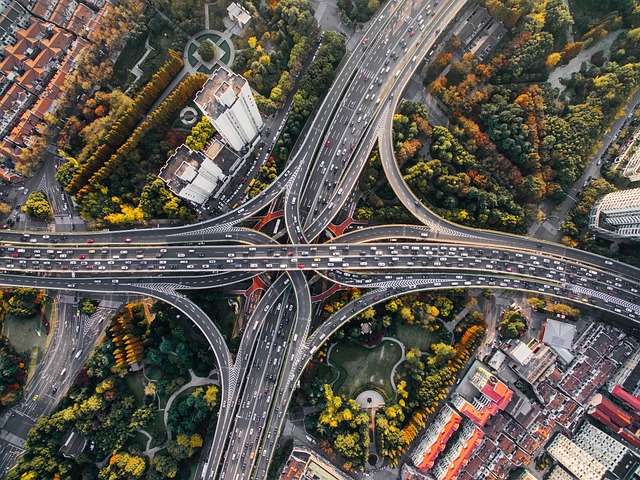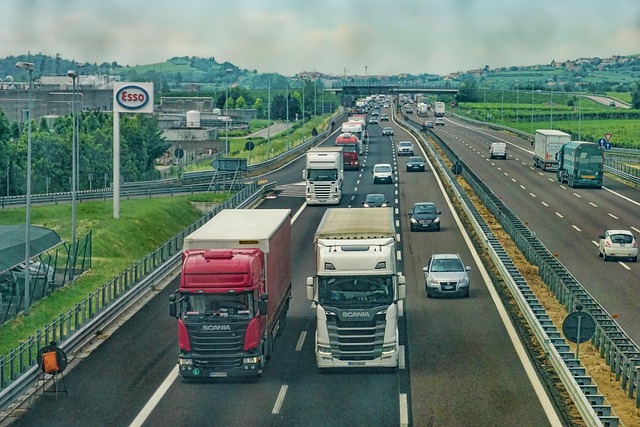In the US, “freeway” typically refers to a toll-free, high-speed road with limited access, while “highway” is a broader term for any major public road.
Freeway Vs. Highway
A freeway, as defined by the Federal Highway Administration (FHWA), is a divided highway with access-controlled ramps and full control of vehicular traffic movements. Freeways are designed to facilitate faster and uninterrupted travel, typically allowing for higher speed limits. They are often characterized by their multiple lanes, overpasses and underpasses, and limited points of entry and exit.
A highway is a general term used to describe a public road that connects various destinations. Highways can encompass a wide range of road types, including two-lane roads, multi-lane roads, and even freeways. Unlike freeways, highways may have traffic lights, intersections, and driveways, making them not fully access-controlled.
What is a Freeway?

A freeway is a type of road or highway that is designed for high-speed, uninterrupted traffic flow. It is characterized by the following features:
- Controlled Access: Freeways have controlled access, which means they typically have on-ramps and off-ramps at designated points. This allows for smooth traffic flow and limits direct access to adjacent properties.
- Divided Lanes: Freeways have multiple lanes that are divided by a median or barrier. This separation helps in managing traffic and reducing the risk of head-on collisions.
- No At-Grade Crossings: Unlike other roads, freeways do not have at-grade crossings such as intersections or traffic lights. Instead, they use interchanges to facilitate the movement of vehicles between the freeway and intersecting roads.
- Higher Speed Limits: Due to their design and controlled access, freeways typically have higher speed limits compared to other types of roads.
- Restricted Access: Freeways often have specific restrictions, such as prohibiting certain types of vehicles (e.g., bicycles or pedestrians) from entering.
- Long Distances: Freeways are designed to cover long distances, connecting cities, regions, or states.
- Designed for Higher Traffic Volume: Freeways are built to accommodate a large volume of traffic, including passenger vehicles, trucks, and buses.
- Managed by Transportation Authorities: Freeways are typically managed and maintained by transportation authorities or government agencies responsible for ensuring their safety, efficiency, and upkeep.
Freeways are designed to provide efficient and safe transportation for high-speed, long-distance travel, while minimizing disruptions and improving traffic flow.
What is a Highway?

A highway is a major public road that connects different cities, towns, or regions. It is designed to accommodate high volumes of traffic and facilitate long-distance travel. Here are some key characteristics of a highway:
- Interconnectivity: Highways are part of a larger network of roads and transportation infrastructure. They are designed to connect different areas, allowing for seamless travel between cities and regions.
- High Capacity: Highways are built to handle large volumes of traffic, including cars, trucks, and other vehicles. They typically have multiple lanes in each direction, allowing for efficient movement of vehicles.
- Speed Limits: Highways often have higher speed limits compared to other types of roads. This is because they are designed for long-distance travel and accommodate vehicles traveling at higher speeds.
- Controlled Access: Highways usually have limited access points, such as ramps or interchanges, to regulate the flow of traffic. This helps maintain safety and efficiency by minimizing conflicts and congestion.
- Long Distances: Highways are intended for long-distance travel, connecting cities, states, or even countries. They provide a faster and more direct route for travelers going from one destination to another.
- Major Transportation Routes: Highways often serve as important transportation corridors, facilitating the movement of goods and people between regions. They play a vital role in regional and national economies.
- Infrastructure and Maintenance: Highways require significant infrastructure, including bridges, overpasses, and toll booths. They also require regular maintenance to ensure safety and operational efficiency.
- Regulations and Laws: Highways are subject to specific regulations and traffic laws to ensure safe and orderly travel. These laws govern speed limits, overtaking, lane usage, and other aspects of highway driving.
In summary, a highway is a major road designed for high-capacity, long-distance travel, connecting different cities and regions. It provides efficient and controlled access for vehicles traveling at higher speeds.
Main Differences Between Freeway and Highway
- Access: Freeways have limited access points, typically achieved through ramps, while highways can have various access points, including intersections and driveways.
- Design: Freeways are designed for high-speed and uninterrupted travel, with multiple lanes, overpasses, and underpasses. Highways can vary in design, ranging from two-lane roads to larger multi-lane roads.
- Speed Limit: Due to their controlled access and design, freeways often have higher speed limits compared to highways. Highways, especially those with traffic lights and intersections, may have lower speed limits.
- Traffic Control: Freeways are equipped with advanced traffic control systems, such as on-ramps, off-ramps, and signage, to guide vehicles efficiently. Highways may have traffic lights, stop signs, and other traffic control measures to manage intersections.
Access
Incorporating access to freeways and highways is one of the main differences between the two. Freeways typically have limited access points, with ramps and interchanges strategically placed to control the flow of traffic. This limited access helps to reduce congestion and improve safety on the freeway. On the other hand, highways usually have more access points, including intersections, traffic lights, and driveways, allowing for easier entry and exit.
This difference in access can affect the speed and efficiency of travel. Freeways, with their restricted access, tend to have higher speed limits and smoother traffic flow. Highways, with more access points, may have lower speed limits and more stop-and-go traffic.
It is important to consider the type of access you prefer when choosing between a freeway and a highway. If you value faster, uninterrupted travel, a freeway may be the better option. If you prefer more convenient entry and exit points, a highway may be more suitable.
Fact: The US Interstate Highway System, which includes freeways, was established in 1956 and is one of the largest public works projects in history.
Design
The design of a freeway and a highway can vary based on their intended purpose and location.
| Freeway | Highway |
| Usually has multiple lanes in each direction | May have multiple or single lanes in each direction |
| Divided by a median or barrier | May or may not have a median or barrier |
| Interchanges or access points are limited and controlled | May have more frequent interchanges or access points |
| Designed to handle high volumes of traffic with minimal interference | Designed to accommodate various traffic volumes and speeds |
| Usually has higher design standards for safety and efficiency | Design standards may vary depending on the location and purpose |
| May have separate carpool or high-occupancy vehicle (HOV) lanes | May or may not have separate carpool or HOV lanes |
The design of a freeway focuses on providing efficient and safe travel for high volumes of traffic, minimizing interference from intersecting roadways or other factors. On the other hand, highway design can vary based on the purpose and location, accommodating different traffic volumes and speeds.
Fact: The Interstate Highway System in the United States, which includes many freeways, spans over 47,000 miles and is one of the largest highway systems in the world.
Speed Limit
The speed limit is a critical aspect to consider when differentiating between a freeway and a highway. In general, freeways tend to have higher speed limits compared to highways. Freeway speed limits often range from 65 to 75 miles per hour (mph), allowing for faster and more efficient travel. On the other hand, highway speed limits are typically lower, ranging from 55 to 65 mph. It is important to note that speed limits can vary depending on the specific location and state regulations.
The higher speed limits on freeways are designed to accommodate the flow of traffic and promote faster travel. This is beneficial for those who need to reach their destination quickly or have long commutes. In contrast, the slightly lower speed limits on highways prioritize safety and are often accompanied by additional traffic control measures such as traffic lights and intersections. These lower speed limits help to prevent accidents and ensure the safety of drivers and pedestrians.
When choosing between a freeway and a highway, it is crucial to consider the speed limit based on your specific travel needs. If you prefer faster travel and have a long journey ahead, a freeway may be the better option. If safety is a top priority or if you are traveling in a more urban area with additional traffic control measures, a highway may be preferable. Ultimately, the choice depends on your personal preferences and the specific conditions of your route.
Traffic Control
Traffic control is a crucial aspect of maintaining safety and efficiency on freeways and highways. The implementation of consistent and effective traffic control measures is essential to ensure a smooth flow of traffic while minimizing congestion.
Various strategies are employed to manage traffic on these roadways. To provide real-time updates on road conditions, accidents, and other important information, variable message signs are used. Additionally, traffic lights are installed at intersections to regulate the flow of vehicles and facilitate safe crossings.
Prominently displayed speed limit signs play a significant role in regulating vehicle speeds and creating a secure driving environment. These signs indicate the maximum speed allowed on the freeway or highway, ensuring that drivers adhere to the specified limits.
Furthermore, lane control signals are utilized to guide traffic flow and effectively manage lane closures or restrictions. These signals effectively communicate with drivers, providing instructions to change lanes or merge when necessary.
To enhance traffic control capabilities, electronic surveillance systems and cameras are installed to monitor traffic conditions. This allows authorities to promptly address any disruptions and make necessary adjustments to improve traffic flow.
Efficient traffic control measures on freeways and highways contribute to safer and more organized travel experiences for drivers. These vital strategies help prevent accidents and minimize delays, ensuring a smooth and enjoyable journey for everyone on the road.
Similarities Between Freeway and Highway
While there are distinct differences between freeways and highways, they also share some similarities:
- Public Roads: Both freeways and highways are public roads that are maintained and regulated by government authorities.
- Primary Transportation Routes: Freeways and highways are designed to serve as primary transportation routes, connecting different areas and facilitating the movement of people and goods.
- High Traffic Volume: Both types of roads often experience high traffic volume, especially during peak hours and in densely populated areas.
- Speed Limits: Freeways and highways typically have higher speed limits compared to local roads and streets. This allows for faster travel and efficient transportation.
- Multiple Lanes: Both freeways and highways generally have multiple lanes in each direction, enabling smoother traffic flow and the ability to overtake slower vehicles.
- Controlled Access: Both types of roads typically have controlled access, meaning they have designated entrances and exits to manage traffic flow and reduce congestion.
- Signage and Markings: Freeways and highways have clear signage and markings to guide drivers, provide information about exits, distances, and directions, and ensure safe navigation.
- Similar Infrastructure: Freeways and highways require similar infrastructure, such as bridges, overpasses, underpasses, and interchanges, to facilitate smooth traffic movement and ensure safety.
- Efficiency and Speed: Both types of roads are designed to facilitate efficient and faster travel, allowing drivers to reach their destinations more quickly compared to local roads.
- Regulations and Laws: Both freeways and highways are subject to traffic regulations and laws, including speed limits, lane usage, and other rules enforced by law enforcement agencies.
While they share these similarities, it is important to note that there are distinct differences between freeways and highways in terms of design, access points, and usage, which should not be overlooked.
Which One Should You Choose?
Choosing between a freeway and a highway depends on various factors:
- Speed and Accessibility: Freeways are designed for higher speeds and typically have limited access points, such as ramps and interchanges. Highways, on the other hand, may have more intersections and driveways, resulting in slower speeds and potential traffic congestion.
- Distance and Travel Time: If you need to cover long distances quickly, freeways are often the better choice due to their higher speeds and limited stops. Highways may be more suitable for shorter distances or if you prefer a more leisurely pace.
- Traffic Conditions: Consider the current traffic conditions when deciding between a freeway and a highway. Freeways tend to have better traffic flow and fewer interruptions, making them ideal for rush hour or congested areas.
- Destination: Evaluate where you are going and the route options available. Some destinations may have better access via freeways, while others may be more easily reached through highways.
- Scenic Routes: If you prefer enjoying scenic views and a more relaxed driving experience, highways often offer a better choice. Highways may take you through rural areas, coastal roads, or mountainous terrains, providing a more picturesque journey.
- Local Regulations: Familiarize yourself with local regulations and restrictions. Freeways often have specific rules, such as minimum speed limits or restrictions on certain types of vehicles. Highways may have different regulations depending on the region.
- Personal Preference: Ultimately, personal preference plays a role in choosing between a freeway and a highway. Consider your comfort level with higher speeds, limited access points, and the overall driving experience you desire.
When deciding between a freeway and a highway, assess the specific circumstances of your journey and choose the option that aligns with your needs, preferences, and the conditions of the route.
Frequently Asked Questions
What is a freeway?
A freeway is a type of controlled-access highway designed for high-speed traffic. It does not have traffic signals or intersections and is accessed through ramps. The opposing traffic is physically separated by a median, and it is regulated via slip roads and a traffic barrier.
What is a highway?
A highway refers to a road that connects different cities, towns, or destinations. It may have long stretches without intersections, but it typically has lower speed limits and may pass through inhabited areas with traffic signals and slower traffic. Highways can include multilane highways, collector roads, arterial thoroughfares, and at-grade crossings.
What is the difference between a freeway and a highway?
The main difference between a freeway and a highway is that a freeway is a type of highway that is designed for high-speed vehicular traffic. It has no traffic signals or intersections, and the opposing traffic is physically separated by a median. In contrast, highways that are not freeways may pass through inhabited areas with traffic signals and slower traffic.
Are all freeways highways?
Yes, all freeways are considered highways. However, not all highways are freeways. The term “highway” is a broader category that includes various types of roads connecting different destinations. Freeways are a specific type of controlled-access highway designed for high-speed traffic.
Who maintains state highways and interstate highways in the United States?
In the United States, state highways are maintained by state governments. On the other hand, interstate highways, most of which are freeways, are maintained jointly by the state and federal government. This collaboration ensures the proper maintenance and management of these major transportation routes.
What are some international names for freeways and highways?
Freeways and highways are known by different names around the world. Some examples include Autobahn (Germany), autopista (Spain), autostrada (Italy), and snelweg (Netherlands). Despite the variations in names, the general concept of a controlled-access highway designed for high-speed traffic remains the same.
Image Credits
Featured Image By – Joe from Pixabay








